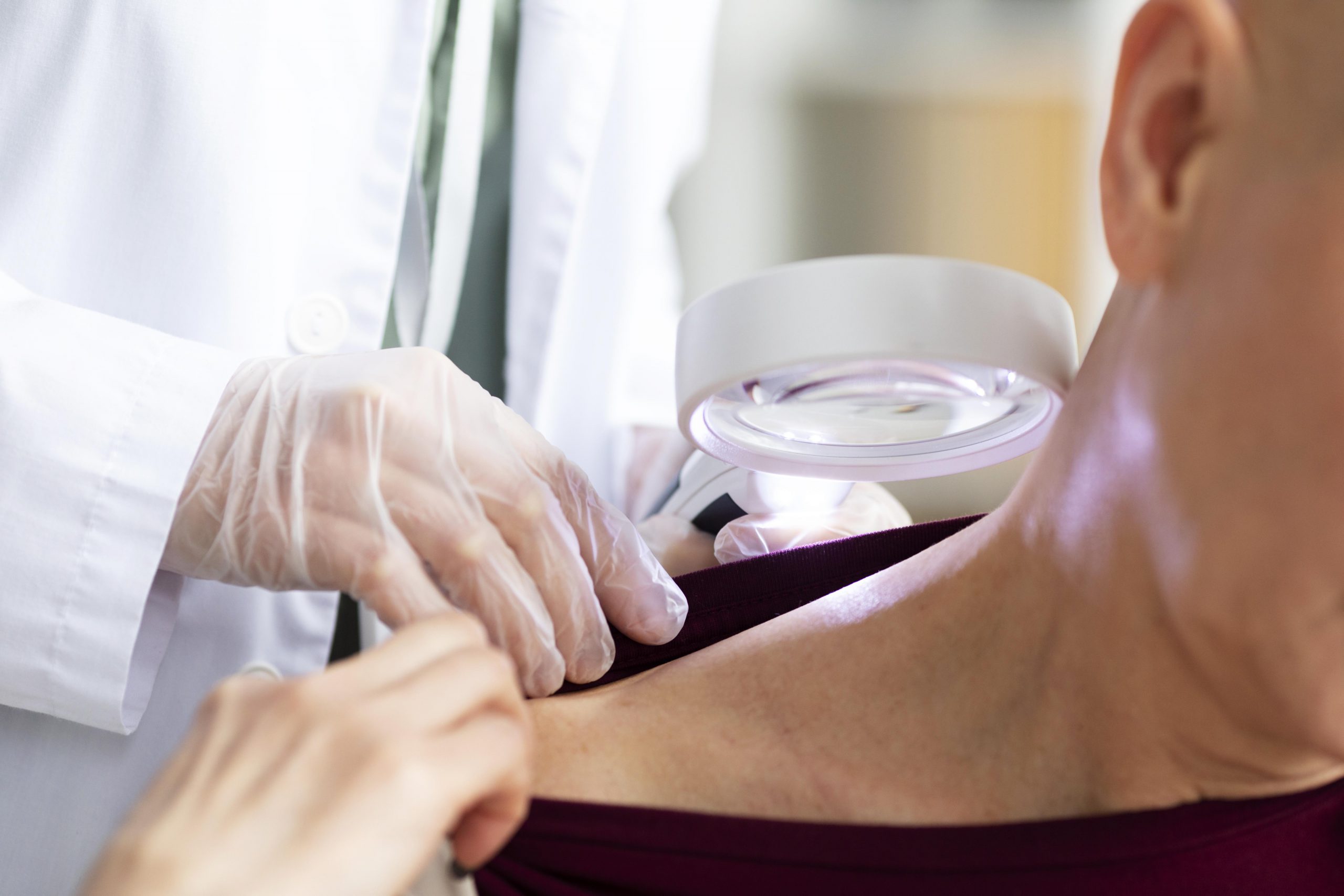Various types of Skin Diseases damage your skin to a significant level, some of them can be temporary while some can be dangerous and permanent, skin disease can vary greatly in symptoms and intensity. Nowadays, skin cancer can be observed in quite a few people who are constantly exposed to the sun. If you find something unusual with your skin, then immediately consult Dermatologist Online and get proper advice regarding your skin issues. Skin cancer treatment depends totally on the stage of skin cancer. The majority of skin cancer diseases can be treated with surgery or in a dermatologist’s clinic. The most common Skin cancer Treatment includes Surgery, Chemotherapy, Radiation therapy, topical treatments, immunotherapy, and Targeted therapy. After a detailed diagnosis of your skin and undergoing skin biopsy; your Dermatologist will opt for any of the above-given treatment methods.
Direct exposure to UV radiation from the Sun is not just dangerous for the skin but also devious. It causes early signs of premature aging and skin cancer. Prevention of skin cancer by protecting yourself requires a broad understanding. Skin cancer can be prevented by using a broad-spectrum sunscreen with SPF of 15 or higher on daily basis, seeking the shade – especially from 10 Am to 04 pm, applying 2 tablespoons of sunscreen to the full body at least 30 mins before going out, avoid tanning, cover the body with clothing, examine skin from head-to-toe quite frequently and visit a dermatologist at least once every 6 months for undergoing a skin exam.
WHAT IS SKIN CANCER?
Skin cancer is caused by growth of abnormal skin cells. These abnormal skin cells majorly develop in the areas which are overexposed to UV rays, but also grow in the area that normally doesn’t get sun exposure. Keratinocyte carcinoma and Melanoma are the two main categories that define the cells involved in Skin Cancer.
Skin cancer affects the areas that come in direct contact with the sun such as the face, lips scalp, ears, arms, hands, chest, and neck. However, the least exposed areas that rarely see light in a day are beneath your toenails or fingernails, palms, and your genital area can also be affected by Skin cancer. Diagnosing the early signs of Skin cancer can help you save time and gives you a great chance for successful Skin cancer treatment. If you observe any suspicious growth or spot on your skin, immediately get in touch with a dermatologist. If the doctor finds out the signs to be cancerous, he will advise you to undergo a biopsy.
CAUSES OF SKIN CANCER:
Skin cancer is caused when mutations develop in the DNA of your skin cells. These mutations cause cells to grow out of control and form a lump of cancerous cells. Skin cancer causes harm to your skin’s top layer – the epidermis. The epidermis is the protective thin layer that provides a cover to skin cells throughout the body. The Epidermis contains 3 main cells: Squamous cells, Basal cells, Melanocytes.
Skin cancer is caused by direct exposure to Ultraviolet rays. When you don’t take care of your skin and let it expose to the UV rays, then it causes tanning beds that can damage your skin’s DNA. So, when your DNA gets altered it leads to skin cancer and it can’t properly control the skin cell growth. Apart from exposure to sunlight, other factors such as getting in contact with toxic substances or having a medical condition that weakens your immune system can raise your chances of getting skin cancer. Also, if your skin gets in touch with long-term exposure to cancer-causing chemicals then it can cause skin cancer.
TYPES OF SKIN CANCER:
Human skin is the body’s largest organ made up of a variety of cells and composed of 3 layers – The epidermis (outer layer of skin), the dermis (inner layer of skin), and the hypodermis (deep layer of fat). Hence, these layers protect the body against skin infection and help regulate the body temperature. Skin cancer is the most common type of cancer found among Americans – with about more than 3 million cases each year.
There are 3 major types of skin cancer: Melanoma, Basal cell carcinoma (BCC), Squamous cell carcinoma (SCC).
An individual is affected by which type of skin cancer is particularly dependent on the location where cancer begins. Like, if cancer begins to grow in skin cells (Basal cells) then the person is affected by Basal cancer or if the cells develop their color on your skin then it is a cause of Melanoma. Hence, one should consider all these types of cancer as serious and start the treatment at the earliest.
- Melanoma: Melanoma is a type of skin cancer where the outer layer of skin (epidermis) meets the inner layer of skin (dermis), and forms scattered cells called Melanocytes. During this process, skin cells produce a brown color-like pigment known as melanin – which is cancerous. Melanocyte is the most serious type of cancer. Melanoma is formed on a face, on an existing mole, on a trunk of men, or most often on the lower legs of women. Melanoma has a high chance of occurring on skin that has not been exposed to UV light.
The early signs of melanoma are:
– A painful bruise that itches or burn
– A painful large bruises on your soles, fingertips, palms, nose, anus, or vagina
– A mole that bleeds and that changes in size, color
– Brownish spot with dark freckles
If you observe any of such signs on your skin, then immediately consult a dermatologist online just to be on the safer side.
- Basal cell carcinoma (BCC): Basal cell carcinoma is a type of skin cancer where flesh-colored round cells, pearl-like moles are found in the lowest part of the outer layer of skin (epidermis). Basal cell cancer is the most common type of cancer usually found in people who have fair skin. The cells of basal cancer tend to grow slowly, and they can’t spread to more distant parts of the body. But there is a chance that basal cancer cells may recur in the same location where they originated if there is frequent exposure to sun & indoor tanning.
One can spot Basal cancer cells on the arms, neck, head, abdomen, legs, and chest. If these cancer cells are not diagnosed at an early stage then they tend to grow deep and treating this type of cancer gets difficult.
Early signs which can help detect Basal cancer include:
– A brown scar-like bruise
– A flat and Fleshy colored round bruises
– A bloody painful sore that heal and return
- Squamous cell carcinoma (SCC): Squamous cell carcinoma is a type of skin cancer that is the second most common type of skin cancer usually found in people whose majority part of the skin is damaged by UV light. Squamous cancer can be aggressive but is generally not life-threatening if diagnosed at the very basic level. Squamous cell cancer is a common type of skin cancer that is found in the middle and outer layers of the skin (epidermis). If these cancer cells are left untreated or ignored then they tend to grow on outer layers of the skin and spread to other areas of the body, which in turn can cause serious complications. Though the majority of SCC can be treated easily and successfully if allowed to grow then the bruises on the skin can become invasive, dangerous, life-threatening, and vandalizing.
Though SCC looks different in every other case early signs which can help you detect SCC include:
– Scaly red patches with irregular borders can sometimes bleed
– A flat bruise with a scaly and crusty surface
– Open sores that bleed and persist for weeks
– Rough, thick, wart-like skin that can occasionally bleed
– SCC can sometimes over bleed, itch, and also may crust
– Redness in the area around genitals
– Elevated growth around your lips with a central depression that bleeds
– A firm, a red module may rapidly increase in size with the passing time
SYMPTOMS OF SKIN CANCER:
When abnormal skin cells tend to grow in the skin after being constantly exposed to the sun, it causes an ailment called skin cancer. Skin cancer is developed in the areas which are highly exposed to the sun such as the neck, arms, and hands, legs, lips, below eyes, ears, chest, and scalp. Areas such as fingernails, toenails, genitals, palms which are least exposed and which rarely see the light of day also have a chance to develop skin cancer.
For people from fair skin complexions to those with darker complexions, skin cancer can affect all types of skin tones. Melanoma cancer is more likely to affect people with darker skin tone and more likely to occur in the areas which are least exposed to the sun such as soles of the feet and palms. While SCC occurs on sun-exposed areas of your body and people with fair skin.
Not all skin cancers tend to be identical and not everyone possesses the same types of symptoms. These signs and symptoms can be dangerous for some people while they can be mild for some others. Still, if you observe some unusual changes in your skin type then it can be a warning sign to get it diagnosed. If you are alert to the changes occurring and get it diagnosed at an earlier stage, then treating the skin cancer can get much easier.
However, putting together some of the common signs and symptoms of skin cancer are as below:
- Skin bruises: A dark spot that develops and doesn’t fade away, a new mole, shiny bump that can be red, pink, or white-colored, sore, scaly red or pink patches on the skin and an unusual growth in skin cells.
- Border: The edges of a healthy and normal mole or freckle should feel smooth but if you experience the bruises that have ragged, raised, uneven edges and notched borders then it can be an early sign of skin cancer.
- Diameter: A mole or a freckle that is larger than the diameter of a pencil eraser about 6 millimeters, then it can be a symptom of skin cancer.
- Change in color: A healthy mole or spot can be found in a uniform color, but if there’s a color variation like if you find some unusual color on the mole of your skin then it can be a symptom of skin cancer. Keep under observation if shades such as white, blue, pink, red and, black appear on your mole.
- Asymmetrical: If the exact two halves of the bruise or mole are uneven or not identical, then it can be a cancerous mole. Because in a healthy mole both the halves will look quite similar.
- Evolving: You might notice the change in color, size, and shape of the mole. Also, take a note of any new bruises, freckles, or moles.
If you observe any of the above skin cancer early signs, then immediately consult a dermatologist online.
TIPS TO PREVENT CANCER:
Skin cancer can be prevented by taking care of a few important points. Some types of skin cancer are developed genetically, while there are lots of things that one can do to prevent the risk of skin cancer. The main source of developing skin cancer is getting in contact with dangerous UV radiation from the sun. After such exposure to UV rays, it not only causes premature aging and the risk of developing skin cancer but also damages the skin cells from within. UV rays reach you out even when you’re trying to avoid it because of pungent clouds and water. UV rays can reach you even when you’re trying to avoid it, like indulging in simple activities like taking a walk, going from your car to the store, taking your dog for a walk; can increase your outdoor exposure to the sun. Henceforth, protecting yourself from skin cancer requires a complete holistic approach.
Here are some tips for skin cancer prevention:
- Consult dermatologist: A dermatologist is a physician who will help cure and treat your skin-related problems. On regular days we don’t usually take a visit to the dermatologist. But ideally one must consult a dermatologist online at least once a year to undergo a professional skin exam. Just like we take care of our body but undergoing regular health checkups at specific time intervals, in the same way, consult a dermatologist for checking up on our skin. If you’re observing any unusual changes to your skin immediately seek a dermatologist who can help you with the diagnosis and advice you with the best treatment.
- Practice sun safety for skin cancer prevention: Isn’t it scary to hear that nearly 5 million people are affected every year cause of skin cancer. It is highly necessary to practice sun safety tips to avoid skin cancer problems. There are a lot of sun safety tips that one can do for skin cancer prevention. Protecting yourself from ultraviolet rays, whether sun or indoor tanning beds is a key to get serious about.
Here are some tips for skin cancer prevention by practicing sun safety:
- Always prefer to wear such clothing that protects your skin while going out and even while staying indoors. If possible wear long pants, fully covered shirts and cover your head with a hat with wide brims. Always prefer to wear protective clothing to prevent UV rays.
- Make a habit to wear sunglasses while going out to protect your eyes from the dangerous UV light. Find a pair of sunglasses that gives you 100% protection.
- Whether you’re staying in or going out, say a no to tanning. A significant level of tanning beds and sun lamps gives growth to cancerous cells.
- Try to limit your sun time from 10 Am to 04 Pm.
- Treating skin becomes a lot easier when diagnosed early. Getting to know your skin better is key to avoiding skin-related issues. Make a habit to observe the skin on a daily basis, if there are any changes such as a change in color, texture, size of moles, etc…
- Try for other sources to get vitamin D, as exposure to the sun is not a safe way to opt for.
- Try to avoid Indoor Tanning: Yes you heard it right. Even while staying indoors you can develop tanning on your skin. It is a myth that staying indoors won’t let your skin tan. Indoor tanning beds are not safer than the sun because they can increase the risk of getting skin cancer. Indoor tanning is the major cause of skin cancer. According to studies, just one session of indoor tanning can cause skin cancer.
- Cover up yourself while going out: While stepping out; always protect your skin from the ultraviolet radiation of sunlight. Prepping your skin with a proper skincare regime followed by protective clothing can help you save from dangerous UV rays. Cover yourself by wearing a set of protective clothing like long-sleeved t-shirts or shirts, covering your head with a hat or cap and long pants while going out.
- Use Sunscreen Daily: Ultraviolet rays can ruin your skin in just 15 minutes. Wearing sunscreen with a minimum of SPF 15 or more is a must while stepping out and also while staying in. There are great benefits of using sunscreen daily as it protects your skin from UV rays hitting the skin. Consulting dermatologists online can help you choose the best sunscreen suitable for your skin type. You need to re-apply sunscreen every 2-3 hours as one stroke of sunscreen does not last the whole day. It is recommended to apply sunscreen on your whole body for at least 20 mins before stepping out.
- Plan your proper diet with help of a dietician: If you are detected with skin cancer then it becomes very necessary to intake a nutritious diet that can help you fight the disease. By consulting the best dietician online, they can help you plan your diet for treating skin cancer. Dieticians will suggest to you the foods which are best to kill Melanoma cancer cells. By introducing the intake of Vitamin C, D, E, Zinc, Omega-3, Beta carotene, Lycopene, Polyphenol, Selenium in your diet can help you fight skin cancer.
- Examine your skin: Make a habit to examine your skin from head to toe daily. If you observe any changes with your skin then consult a dermatologist online regularly. With increased pollution, constant exposure to the sun, and applying makeup on the skin; nowadays keeping skin healthy has been such a task. Sticking to a good skincare regime can help you deal with skin-related issues by keeping your skin healthy. A dermatologist recommended sunscreen should be part of your skincare routine to keep your skin safe from UV rays. Examining your skin on a regular basis can help you with the best treatment at the earliest stage.
If you are diagnosed with any symptoms related to skin cancer or looking for a dermatologist to help you deal with skin-related issues; then visit our website Mediflam and get a consultation from the best dieticians online.
FREQUENTLY ASKED QUESTIONS ABOUT SKIN CANCER:
- How do you know if a spot is skin cancer?
- Skin cancer is usually developed in the areas which are highly exposed to the sun such as the neck, arms, and hands, legs, lips, below eyes, ears, chest, and scalp. Areas such as fingernails, toenails, genitals, palms which are least exposed and which rarely see the light of day also have a chance to develop skin cancer.
- If there’s a spot or mole on your body which does not look like others on your body then it needs to get tested whether this is a sign of skin cancer.
- If the sore doesn’t heal or if the redness or swelling of spot/mole tends to increase larger than the borders.
- If you experience that itching, pain, and redness goes away and comes back
- If there are changes on the surface of the spot such as bleeding, appearance, itchiness
- If you observe any of such skin cancer symptoms then the spot is a sign of skin cancer.
- What does early-stage Melanoma look like?
The early signs of Melanoma skin cancer are:
- A painful bruise that itches or burn
- Painful large bruises on your soles, fingertips, palms, nose, anus, or vagina
- A mole that bleeds and that changes in size, color
- Brownish spot with dark freckles
- A small mole that has irregular borders that appears red, white, pink, blue, or black. Changing colors are the warning sign of early-stage Melanoma.
If you experience any of such signs of Melanoma then immediately consult a Dermatologist online
- What does skin cancer do?
- Diagnosing skin cancer is a life-changing experience. Not only does it affect your skin but fear, anxiety, depression of cancer coming back after treatment can kill you from inside. Once a skin cancer diagnosis is received, researchers have found out that it affects your quality of life. Even post-treatment, after-effects of skin cancer such as being scared of the sun, changes in daily routine activities, getting to know your skin all over again can cause a huge impact on life.
- After being detected with skin cancer; instigating a new relationship with your skin, keeping an eye on your health, finding the support of a caregiver becomes an important part of your routine.
- What is the most common treatment for skin cancer?
- Skin cancer treatment options depend totally on the type of skin cancer you are diagnosed with. Most of the skin cancer treatment can be performed in dermatologist clinics. However, most common skin cancers can be treated with surgery. Especially Basal cancer cells and squamous cancer cells can be removed by a dermatologist through an outpatient process. While aggressive cancer cells are removed through extensive surgery.
- Other common skin cancer treatment includes Chemotherapy, Radiation therapy, immunotherapy, simple excursion, Shave excursion, cryosurgery, Mohs surgery, Biological therapy, freezing, photodynamic therapy, and curettage and electrodesiccation.
- What happens if you let skin cancer go untreated?
- Skin cancer usually cannot go by itself. Keratoacanthoma is a rare type of skin cancer that looks like a dome-shaped tumor on the skin which is exposed to the sun; this type of cancer can shrink and goes away on its own without any treatment. However, this type of cancer is rare but it can spread to various parts of your body.
- If other aggressive cancer cells like BCC or SCC go untreated then they can expand and cause ulcers and damage your skin tissues. If these dangerous cancer cells are left untreated then they can do permanent damage to your skin and have a bad impact on the way you look.
- If skin cancer goes untreated then the moles or bruises tend to grow deeper into the skin and can damage surrounding skin, tissue, and bone and can turn out to be life-threatening.
- So, skin cancer treatment becomes of utmost importance to treat cancer cells.











